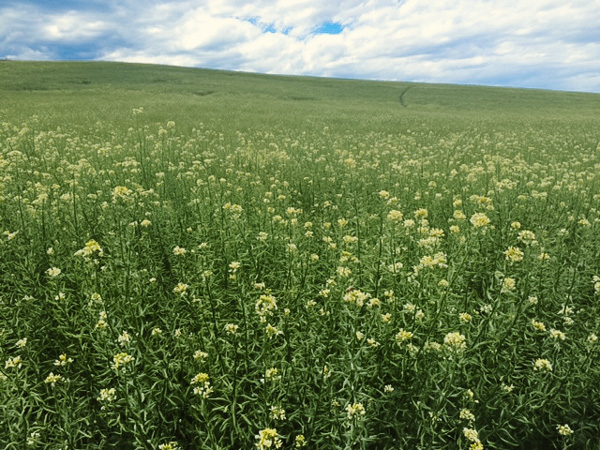Cropping Applications
Nematode Control
Mighty Mustard®: The proven nematode suppressor
To suppress nematodes, you need high levels of the right glucosinolates. Mighty Mustard® Kodiak and Pacific Gold contain high concentrations of Sinigrin glucosinolates (a.k.a. Allyl or 2-Propenyl), which are biologically toxic to some harmful nematodes.

How Mighty Mustard® biofumigation works

Mighty Mustard® contains high levels of potent glucosinolates (GSLs), the biotoxic compounds that make mustard spicy and act as natural fumigants. Chopping Mighty Mustard® breaks the plant cell walls, releasing GSLs into the soil.
Adding water to the chopped mustard triggers the glucosinolates to release natural chemical compounds called isothiocyanates (ITCs). At high concentrations, ITCs behave similarly to commercial pesticides and herbicides. Trusted by potato growers for 20 years, Mighty Mustard® is proven to contain high concentrations of the GSLs and ITCs necessary to target nematodes.
Nematode Suppression Protocol
It’s crucial to follow the incorporation protocol listed below. If you don’t, you run the risk of allowing nematodes to reproduce and increase populations.
- At the first sign of flowering, chop mustard as finely as possible.
- Immediately incorporate into soil.
- Immediately water soil or pull a roller over it to create a seal. **The incorporation process is time-sensitive, so it’s crucial to complete all the actions in one day. DON’T leave a trash layer of mustard organic matter on top of the soil.** PLEASE NOTE that moisture is key, as the glucosinolates are short-lived, so you need to release them into the soil ASAP to suppress nematodes.
- Allow three weeks between time of incorporation and the planting of your next crop.
Important rules to remember
- Obtain soil tests prior to planting, to accurately assess nematode populations. Research has shown that cover crops will not be effective if nematode populations are excessively high. Wait a minimum of three weeks after incorporation to conduct a follow-up soil test to determine the impact on nematodes.
- Consult your county extension agent when possible. They’ll assist with soil tests and share expertise on what’s worked for other growers in your area.
- For nematode control, plant a monocrop of Mighty Mustard® instead of a cover crop blend.
- Researchers recommend growing mustard cover crops to enhance, not replace chemical nematicides. Grown successfully, Mighty Mustard® improves soil health while suppressing nematodes.
- Start with a small test plot and monitor the results. Read more helpful tips from Washington State University for getting started with green manures.
- If you’ve used broadleaf herbicides, check the plant-back guidelines before planting Mighty Mustard® or other cover crops.
- Fall incorporation has been proven most effective for suppressing nematodes and soilborne diseases.
- ALWAYS follow the planting protocol outlined above.
- Trap crop or host crop?
Some companies claim their mustards are “trap crops” while others are “host crops” for nematodes. Nematologists offer varying opinions. One nematologist told us, “The majority of brassicas are fair to good hosts.” But Dr. Marisol Berti of North Dakota State University told us Mighty Mustard® is a non-host to soybean cyst nematodes. We’ll provide updates as research trials continue. - For best results, follow the Mighty Mustard® Nematode Suppression Protocol that’s outlined above.
Download & Print the Mighty Mustard® Nematode Suppression Protocol PDF
The Mighty Mustard® Guarantee:
- We provide full transparency from our farms to your fields
- Independent lab analysis provided for every lot, so you know exactly what’s in the bag
- We offer customized agronomy support
- Guaranteed to be Certified, untreated, PVP planting seed
- Always Non-GMO Project verified
- Grows well in cooler climates
- Proven effective by 25 years of independent research and on-farm results
- Seed grown on Pacific Northwest family farms
- Non-toxic and safe to use around children & pets
